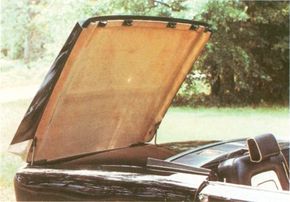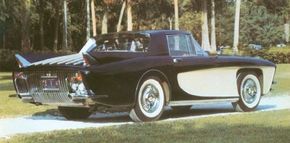The 1955-1957 Gaylord, one of the most intriguing vehicles in auto history, was designed by an unlikely duo. Jim and Ed Gaylord were heirs to a fortune: their father had invented the bobby pin, an inoffensive little piece of metal that proved to be worth a couple dozen oil wells on the world market.
Advertisement
Growing up in the late 1930s, the brothers Gaylord could have anything they wanted. Most often this turned out to be a fast car, anything from the 1949 V-8 Cadillac which Ed claimed would lose a Jaguar on Chicago's Lake Shore Drive, to the cream of European exotica.
But Jim and Ed were not your run-of-the-mill rich kids; they were natural engineers, who made it their business to learn everything they could about cars. When in 1954 they decided to build the ultimate production sports car, those who knew them actually thought they might succeed.
The concept of the 1955-1957 Gaylord was world-class performance combined with luxury-car refinement: total isolation from noise and vibration. To achieve these seeming self-canceling goals, the Gaylords decided to spend whatever it took, hence the 1955-1957 Gaylord's estimated retail price of $10,000. (Jim soon decided this was not enough to cover costs, so he blithely raised the tab to $17,500.)
The frame was constructed of chrome-moly tubing, to which were attached channel steel perimeters and a strong steel platform. The insides of the tubes were rustproofed and all were sealed, making condensation impossible.
The suspension of the 1955-1957 Gaylord looked conventional, but wasn't. The independent front wishbones used oversized rubber bushings and had "maximum triangulation," in Jim Gaylord's words. This gave enormous wheel travel, but relatively little movement at the mounting points. The suspension was lubed with permanent molybdenum disulfide; ten years before the no-grease chassis, the Gaylords put one on the street.
Detail features on the 1955-1957 Gaylord included variable-ratio power steering (controlled manually with a dashboard knob); modified Hydra-Matic (no shift occurred until peak rpm was reached in any gear, unless it was shifted manually); a "no-creep" feature; double-safe instruments featuring both needle gauges and warning lights. The engine was initially a 331 Chrysler hemi, but Ed Cole convinced the brothers that the 1956 Cadillac 365 was lighter and quieter.
To learn more about the development and design of the 1955-1957 Gaylord, keep reading.
For more information on cars, see:
- Classic Cars
- Muscle Cars
- Sports Cars
- Consumer Guide New Car Search
- Consumer Guide Used Car Search
Advertisement


